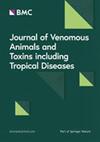三种声母蛛属蜘蛛的比较毒性分析
IF 1.8
3区 医学
Q4 TOXICOLOGY
Journal of Venomous Animals and Toxins Including Tropical Diseases
Pub Date : 2022-02-09
DOI:10.1590/1678-9199-JVATITD-2021-0042
引用次数: 2
摘要
背景:蜘蛛毒液通过与分子靶点的高亲和力结合而诱导不同的生理药理作用,因此具有生物技术的研究价值。其中一些毒素作用于不同类型的离子通道,已在主要来自P. nigriventer的Phoneutria属蜘蛛的毒液中发现。尽管P. nigriventer毒素显示出药物潜力,但由于其毒素的特征仍然很差,因此关于同一属毒液分子的信息有限。了解这种多样性,阐明蜘蛛毒素作用机制的差异,对于确定其真正的生物技术潜力具有重要意义。这促使我们比较了三种不同的Phoneutria属毒液:P. nigriventer (Pn-V), P. eickstedtae (Pe-V)和P. pertyi (Pp-V)。方法:采用SDS-PAGE、HPLC、质谱、酶活性、电生理(全细胞膜片钳)等方法对毒液进行生化和功能比较。结果:采用的方法显示,所有三种毒液在其成分上具有总体相似性,只有微小的差异。明显存在大量的相似蛋白,特别是在~6.0 kDa的质量范围内的毒素。除毒素Tx1和Tx2-6亚型外,所有毒液中均检测到透明质酸酶和蛋白水解活性。所有Tx1异构体都能阻断Nav1.6离子电流,差异不大。结论:我们的研究结果表明,Pn-V, Pe-V和Pp-V在蛋白质组成和酶活性方面高度相似,含有相同毒素的同种异构体,具有高度的序列同源性,只有少量的修饰。然而,这些结构和功能的变化对毒液的多样性非常重要。此外,我们的研究结果将有助于理解声母属其他物种毒液的分子多样性,揭示其作为寻找新的活性分子的生物技术潜力。本文章由计算机程序翻译,如有差异,请以英文原文为准。
Comparative venomic profiles of three spiders of the genus Phoneutria
Abstract Background: Spider venoms induce different physio-pharmacological effects by binding with high affinity on molecular targets, therefore being of biotechnological interest. Some of these toxins, acting on different types of ion channels, have been identified in the venom of spiders of the genus Phoneutria, mainly from P. nigriventer. In spite of the pharmaceutical potential demonstrated by P. nigriventer toxins, there is limited information on molecules from venoms of the same genus, as their toxins remain poorly characterized. Understanding this diversity and clarifying the differences in the mechanisms of action of spider toxins is of great importance for establishing their true biotechnological potential. This prompted us to compare three different venoms of the Phoneutria genus: P. nigriventer (Pn-V), P. eickstedtae (Pe-V) and P. pertyi (Pp-V). Methods: Biochemical and functional comparison of the venoms were carried out by SDS-PAGE, HPLC, mass spectrometry, enzymatic activities and electrophysiological assays (whole-cell patch clamp). Results: The employed approach revealed that all three venoms had an overall similarity in their components, with only minor differences. The presence of a high number of similar proteins was evident, particularly toxins in the mass range of ~6.0 kDa. Hyaluronidase and proteolytic activities were detected in all venoms, in addition to isoforms of the toxins Tx1 and Tx2-6. All Tx1 isoforms blocked Nav1.6 ion currents, with slight differences. Conclusion: Our findings showed that Pn-V, Pe-V and Pp-V are highly similar concerning protein composition and enzymatic activities, containing isoforms of the same toxins sharing high sequence homology, with minor modifications. However, these structural and functional variations are very important for venom diversity. In addition, our findings will contribute to the comprehension of the molecular diversity of the venoms of the other species from Phoneutria genus, exposing their biotechnological potential as a source for searching for new active molecules.
求助全文
通过发布文献求助,成功后即可免费获取论文全文。
去求助
来源期刊
CiteScore
4.80
自引率
8.30%
发文量
39
审稿时长
6-12 weeks
期刊介绍:
Journal of Venomous Animals and Toxins including Tropical Diseases (JVATiTD) is a non-commercial academic open access publication dedicated to research on all aspects of toxinology, venomous animals and tropical diseases. Its interdisciplinary content includes original scientific articles covering research on toxins derived from animals, plants and microorganisms. Topics of interest include, but are not limited to:systematics and morphology of venomous animals;physiology, biochemistry, pharmacology and immunology of toxins;epidemiology, clinical aspects and treatment of envenoming by different animals, plants and microorganisms;development and evaluation of antivenoms and toxin-derivative products;epidemiology, clinical aspects and treatment of tropical diseases (caused by virus, bacteria, algae, fungi and parasites) including the neglected tropical diseases (NTDs) defined by the World Health Organization.

 求助内容:
求助内容: 应助结果提醒方式:
应助结果提醒方式:


